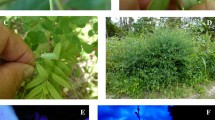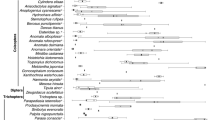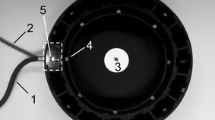Abstract
Conservation of rare and elusive butterflies can benefit from the use of contrasting survey techniques to confirm their presence and to understand the lifecycle in more detail. This case study trialed different survey techniques for all stages of the lifecycle (ova, larva, pupa and adult) to assess their value for monitoring Black Hairstreak (Satyrium pruni) populations in Britain.
Daytime surveys for well camouflaged ova, larvae and pupae yielded little success. However, the novel use of UV flashlights in nocturnal surveys for photoluminescent larvae was found to be an effective technique when compared to surveying adult butterflies. Critically, combined surveying for larvae and adults provides unique insights into the behaviour of the species at different stages in the lifecycle and, when used in combination, gives a more holistic understanding of the true nature of a colony of Black Hairstreak butterflies.
Implications for insect conservation: our results show that the novel use of nocturnal surveys for larvae with UV flashlights is a valuable technique for surveying for Black Hairstreak butterflies. It therefore has potential to be used in conjunction with other survey techniques for assessing the health of a colony and supporting conservation at different stages of the lifecycle of the butterfly.
Similar content being viewed by others
Avoid common mistakes on your manuscript.
Introduction
The accurate monitoring of butterfly populations can serve as a valuable indicator of ecosystem health, determine the impacts of environmental changes and contribute towards the conservation of threatened species (Polgar et al 2013; Thomas et al 2004). However, several species of butterfly are difficult to monitor because certain lifecycle stages are cryptic (Lindzey and Connor 2011; Moskowitz 2021).This can lead to inaccurate estimates of population densities in monitored colonies or to established colonies being overlooked (Pollard and Yates 1993). Also, where specific lifecycle stages are difficult to monitor, critical information for conservation can be missed, for example, the symbiotic relationship between the larvae of the Large Blue (Phengaris arion) and Myrmica ants, (Thomas 1980).
The Black Hairstreak is a rare and elusive butterfly, in Britain it is found only in Blackthorn (Prunus spinosa) scrub on heavy clay soils (Eeles 2019; Thomas and Lewington 2014) and has legal protection against being collected (Bourn and Warren 1998). The species is difficult to observe at all stages of its lifecycle. Adults are rarely observed at ground level, typically residing high in trees such as Oak (Quercus robur) or in Blackthorn scrub where they feed on honeydew secreted by aphids (Fig. 1a). This means that they tend not to be recorded by traditional methods of surveying such as transect walks because recorders focus their attention at lower levels (Pollard and Yates 1993). The adult is sedentary for long periods when feeding or basking, interspersed between brief periods of flight which are dependent on weather conditions. It is small (c.37 mm wingspan), can easily be confused with other similar species such as the White-letter Hairstreak (Satyrium w-album) (Salmon 2001) and has a relatively short flight period (Eeles 2019; Thomas 1974; Thomas and Lewington 2014). Collectively, these features mean that as an adult, the species can easily be missed in conventional surveys or, where targeted surveys are being undertaken, confidence that the numbers recorded accurately reflects the number present can be low.
Life history stages of the Black Hairstreak butterfly: a adult male perched on Blackthorn leaf. b Ovum showing crypsis against Blackthorn twig. c Fourth (final) instar larva showing camouflage against Blackthorn leaves. d Pupa, displaying mimicry of a bird’s dropping. e Larva exhibiting luminescence under UV flashlight
Black Hairstreak ova (shown in Fig. 1b) can be extremely difficult to find due to their size and camouflaged colour (Field 2006; Hermann 2007; Koschuh 2004). Thomas observed that “to find two or three an hour is very good going, whereas one might find 100 Brown Hairstreak (Thecla betulae) eggs for the same amount of searching” (Thomas and Lewington 2014), because the latter are white and have a more distinctive structure. The larval stages of all hairstreak species are also extremely well camouflaged (Eeles 2019). On hatching, first instar (L1) Black Hairstreak larvae feed on flowering buds (Thomas and Lewington 2014). At L2 they change colour to match blackthorn leaves, and this continues as they mature through L3 and L4 instars (Fig. 1c). Their pupae mimic bird-droppings (Fig. 1d) and can also be difficult to locate in the wild, however, even with this protection, loss from predators can be as high as 80% at this stage (Thomas and Lewington 2014).
Luminescence of larvae under UV light has previously been reported in certain butterflies including lycaenids (Kevin et al 2019; Moskowitz 2017, 2018, 2020, 2021). This trait has been shown to reduce avian predation by comparing bird strikes on plasticine larvae models painted with fluorescent treatments against unpainted controls (Czarnecki et al. 2022).
Previous research successfully demonstrated the potential of using nocturnal UV flashlight surveys to study rare species using the Frosted Elfin (Callophyrs irus) butterfly as a test case. This found that nocturnal UV surveys were highly effective at reducing surveying time and increasing the number of larvae found when compared to daytime searches (Moskowitz 2020).
In this study, we build on this work by showing for the first time, that the larvae of Black Hairstreak luminesce under UV light. We also applied a combination of novel nocturnal UV flashlight surveys and traditional daytime survey techniques in order to compare the effectiveness of different methodologies for surveying Black Hairstreaks. This work aimed to trial improved methodologies for recording, develop a more detailed understanding of cryptic and elusive butterflies, and to support their conservation.
Methodology
Our case study area was in Surrey, UK. The 5 sites (A-E) chosen were where most adults were recorded in 2021. The patches of blackthorn scrub surveyed had the following common characteristics: they were mature (typically between 5 and 10 years in age), between 1.5 m and 3 m in height, with an aspect open to sunlight, being located close to an Oak tree (Quercus robur). Two sites were areas of scrub either side of paths, and three sites were in areas of blackthorn scrub partially underneath, or near to, an Oak tree in open areas. The length of blackthorn edge surveyed at each site was between 10 and 20 m. Due to their proximity, sites A, B and C were surveyed on the same dates, and sites D and E were surveyed on the same dates.
Surveyors primarily employed portable ultra-violet lighting provided by an Alonefire™ SV13 UV Flashlight comprising a 15W UV LED light source emitting at 365 nm and providing 2800mW luminous power. UV flashlights that emit at 395 nm are more commonly available, therefore, a standard 100 LED UV flashlight was used to test photoluminescence at this wavelength. Surveyors always wore UV-protective glasses. Larval surveys were conducted after dusk until 12 pm, on nights when the blackthorn leaves were dry. Timed counts consisted of scanning the blackthorn foliage for ten minutes using the light in a sweeping motion and recording the number and position of any larvae found.
Surveys for adult butterflies adopted the protocol used by the UK Butterfly Monitoring Scheme (Pollard and Yates 1993), recording between 10:45 and 15:45 and only in suitable weather (no rainfall, with wind speed less than Beaufort scale 5, minimum temperature 13 °C if at least 60% sunshine, or more than 17 °C if overcast). Surveyors searched the habitat from ground level to the upper branches of suitable trees (using a Nikon Coolpix™ B700 camera zoom to confirm identification) for ten minutes at each location.
Daytime searches for Black Hairstreak ova, larvae and pupae were undertaken in February, late May and early June 2021 respectively. Three nocturnal searches for larvae were undertaken at each site from 24th April to 13th May 2022, timed to coincide with the late larval stages, L3 and L4. A total of six surveys were undertaken at each site for adult butterflies over a 4-week period from 28th May 2022 to the 21st June 2022.
Results
Daytime surveys for ova and pupae yielded no results in ten hours of surveying. Daytime searches for larvae in late May 2021 resulted in successfully locating only a single L4 caterpillar in 10 h.
Nocturnal surveying with UV flashlights showed that L2, L3 and L4 Black Hairstreak larvae luminesce strongly under UV light (Fig. 1e) and are readily detectable at distances up to c.3 m with both 365 nm and 395 nm emitting flashlights. Neither ova nor pupae were found to be more detectable under UV light.
Surveying commenced when most larvae found were at L3 stage (a single L2 larva was recorded on 28th April). This technique proved increasingly successful, with observed numbers rising as the larvae increased in size and transitioned to the L4 stage. On 6th May a survey of Sites D and E yielded a combined total of 13 larvae, and on May 9th Sites A, B and C yielded a total of 46 larvae. The number of larvae recorded then declined as they transitioned to pupae or potentially suffered from predation. By 13th May, only 1 larva was observed at Site D, and none were observed at the other sites.
Surveying for adult butterflies showed that numbers steadily increased from 28th May to a peak on 10th June (Fig. 2). The number of butterflies then declined, and during surveys on 21st June only two adults were observed, one at Site A and one at Site C.
Different survey techniques can be expected to yield different results. The data for peak numbers at each survey point show that an equal or greater number of larvae compared to adults were found at all sites (Table 1). One location, Site C, was surveyed six times and a single adult was seen on only two occasions, whereas the maximum number of larvae observed was 22.
Discussion
We have demonstrated for the first time that the larvae of Black Hairstreak butterflies luminesce under UV light. We also show that nocturnal UV flashlight surveys have the potential to serve as a reliable and consistent methodology for determining presence, population density and distribution for Black Hairstreak butterflies and potentially other cryptic or elusive species. Our comparison of techniques for surveying butterflies at different stages in their life cycle (Table 2). The main disadvantage concerns night-time working and the associated safety risks. The technique is also weather dependent in that rainwater on leaves can reflect UV flashlight, making dry nights preferable for surveying.
Although daytime surveys for ova, larvae and pupae proved to be time-consuming with few positive results, it should be noted that even a single record can provide useful evidence of a breeding colony. In contrast, surveys under UV flashlight were highly successful in detecting many larvae that would otherwise have been missed by conventional daytime searches. Therefore, this technique could successfully be used as a method to determine the presence of Black Hairstreak butterflies, or to determine the distribution of poorly understood populations. It could also be used to understand the larval stage in more detail, including survival rates to adult. Critically, this study shows that combining night-time UV flashlight surveys for larvae with daytime surveys of adults can provide a more holistic understanding of the lifecycle of the species.
When conducting surveys, larvae of other species were also found to luminesce under UV flashlight. A more comprehensive survey of which species exhibit such luminescence would be instructive. We suggest that the use of night-time UV flashlight surveys for larvae could be widely applicable for monitoring other species of butterfly and moth, and possibly other insect taxa, especially where this stage of their lifecycle is highly cryptic in daylight.
Availability of data and materials
All data is available on request to the corresponding author.
References
Bourn NAD, Warren M (1998) Species Action Plan. Black Hairstreak (Satyrium pruni) Butterfly Conservation, Wareham, Dorset, https://butterfly-conservation.org/sites/default/files/black-hairstreak-action-plan.doc
Czarnecki C, Manderino R, Parry D (2022) Reduced avian predation on an ultraviolet-fluorescing caterpillar model. Can Entomol 154(e10):1–7
Eeles P (2019) Life cycles of British Butterflies. Pisces Publications, Newbury
Field R (2006), Black Hairstreak Satyrium pruni in Cambridgeshire, Butterfly Conservation. www.cambs-essex-butterflies.org.uk/downloads/BlackHairstreakfinal.pdf
Hermann G (2007) Searching for butterflies in winter. Hairstreaks, Purple Emperors, Poplar Admiral and White Admirals. ISBN 978-3-8334-9643-1
Kevin R, Yoonjung Y, Amaël B (2019) UV biofluorescence in swallowtail butterfly larvae. Front Ecol Environ 17(8):444
Koschuh A (2004) Field observation of eggs of the black hairstreak Satyrium pruni in the southern part of Styria (Austria), Nachr. entomol. Ver. Apollo, N. F. 25(4):181–184
Lindzey S, Connor E (2011) Monitoring the mission blue butterfly using immature stages. J Insect Conserv 15:765–773
Moskowitz D (2017) Caterpillar hunting with a UV flashlight. News Lepid Soc 59(1):42–44
Moskowitz D (2018) Hunting caterpillars with a UV flashlight—Part 2. News Lepid Soc 60(4):169–171
Moskowitz D (2020) Surveying for caterpillars of a rare butterfly using ultraviolet light: the Frosted Elfin butterfly (Callophyrs irus) as a test case. J Insect Conserv 24:321–326
Moskowitz D (2021) Foiling crypsis: Surveying Lepidoptera caterpillars with UV light. Entomologist's Monthly Magazine, Volume 157, Number 1, 26 February 2021, pp 9–16(8)
Polgar CA, Richard B, Primack RB, Williams EH, Stichter S, Hitchcock C (2013) Climate effects on the flight period of Lycaenid butterflies in Massachusetts. Biol Cons 160:25–31
Pollard E, Yates TJ (1993) Monitoring butterflies for ecology and conservation. Chapman and Hall, London
Salmon MA (2001) The Aurelian legacy: british butterflies and their collectors. University of California Press
Thomas JA (1980) Why did the large blue become extinct in Britain? Oryx 15(3):243–247
Thomas J, Lewington R (2014) Butterflies of Britain and Ireland. Bloomsbury, London
Thomas JA, Telfer MG, Roy DB, Preston CD, Greenwood JJD, Asher J, Fox R, Clarke RT, Lawton JH (2004) Comparative losses of British butterflies, birds, and plants and the global extinction crisis. Science 303:1879–1881
Thomas J (1974) Factors influencing the numbers and distribution of the Brown Hairstreak, Thecla betulae L. and the Black Hairstreak, Strymonidia pruni L. PhD thesis, University of Leicester
Acknowledgements
The authors would like to thank the two anonymous reviewers for their highly constructive comments and feedback. The authors also are grateful to Nicola Campana-Etheridge, Sarah Clift, Stewart Cocker, Bill Downey, Alison Gilry, Pamela Harwood, Peter Howarth, Steve Nevard, Robb Reeves, Simon Saville, Peter Vigar and Bob Yeo for their help and support.
Author information
Authors and Affiliations
Contributions
All authors contributed to the study conception and design. Material preparation, data collection and analysis were performed by GT. The first draft of the manuscript was written by GT and all authors commented on subsequent versions of the manuscript. All authors read and approved the final manuscript.
Corresponding author
Ethics declarations
Conflict of interest
The authors did not receive support from any organization for the submitted work. No funding was received to assist with the preparation of this manuscript. No funding was received for conducting this study. No funds, grants, or other support was received.
Ethical approval
Not applicable.
Additional information
Publisher's Note
Springer Nature remains neutral with regard to jurisdictional claims in published maps and institutional affiliations.
Rights and permissions
Open Access This article is licensed under a Creative Commons Attribution 4.0 International License, which permits use, sharing, adaptation, distribution and reproduction in any medium or format, as long as you give appropriate credit to the original author(s) and the source, provide a link to the Creative Commons licence, and indicate if changes were made. The images or other third party material in this article are included in the article's Creative Commons licence, unless indicated otherwise in a credit line to the material. If material is not included in the article's Creative Commons licence and your intended use is not permitted by statutory regulation or exceeds the permitted use, you will need to obtain permission directly from the copyright holder. To view a copy of this licence, visit http://creativecommons.org/licenses/by/4.0/.
About this article
Cite this article
Tilley, G.J., Anderson, M. & Stewart, A.J.A. Evaluating the use of UV photoluminescence for surveying the immature stages of rare butterflies: a case study using the Black Hairstreak (Satyrium pruni). J Insect Conserv 27, 571–575 (2023). https://doi.org/10.1007/s10841-023-00480-0
Received:
Accepted:
Published:
Issue Date:
DOI: https://doi.org/10.1007/s10841-023-00480-0






